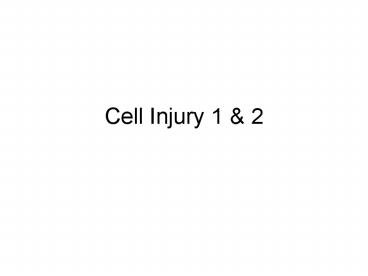Cell Injury 1 & 2 - PowerPoint PPT Presentation
1 / 96
Title:
Cell Injury 1 & 2
Description:
Cell Injury 1 & 2 Slide 11: Vacuolar Degeneration Kidney Renal tubules Note tiny small vacuoles Displaced nucleus to the side Glomerulus Slide 30 Intestine Caseation ... – PowerPoint PPT presentation
Number of Views:29
Avg rating:3.0/5.0
Title: Cell Injury 1 & 2
1
Cell Injury 1 2
2
(No Transcript)
3
Slide 11Vacuolar Degeneration Kidney
- Renal tubules
- Note tiny small vacuoles
- Displaced nucleus to the side
- Glomerulus
4
(No Transcript)
5
(No Transcript)
6
(No Transcript)
7
Slide 30Intestine Caseation Necrosis
- Casseation Necrosis - Tuberculosis -
- Irreversible injury
- Grossly like cheese soft, whitish, crumbly -
casseous ? cassation necrosis - Surrounded by epitheloid cells, giant cells,
necrotic area. - On X-ray report Fibrocasseous density
- Fibrotic center
- After treatment fibrocalcitic area/fibrotic area
8
(No Transcript)
9
(No Transcript)
10
(No Transcript)
11
(No Transcript)
12
Slide 96Enzymatic Fat Necrosis (Pancreas)
- Acute hemorrhagic pancreatitis necrosis
- Exocrine function -- CHO, Fats, Lipid enzymes
- Enzymes leak out of pancreas lipase ? digests
- Peripancreatic tissue gets digested ? produced
fatty acids, and stays in the tissue. - Sapponified fat - see shadowy outlines of the fat
cells, containing this. Whitish, opaque, crumbly. - Severe abdominal pain.
- Note the following
- Normal pancreatic tissue
- Necrosis of peripancreatic fats by enzymes
released from pancreas
13
(No Transcript)
14
(No Transcript)
15
(No Transcript)
16
Slide (no number)Lung Abscess
- Abscess - plenty of neutrophils/enzymes
- Irreversible
- Heterolysis
- Liquifies tissue
- Pus formation
- Note
- Lung abscess digestion of lung tissue producing
a cavity filled with neutrophils and necrotic
material - Alveoli with PMNs and edema
17
(No Transcript)
18
(No Transcript)
19
(No Transcript)
20
(No Transcript)
21
Fatty change, liver
- Fat accumulation inside hepatocyte as colorless
vacuoles
22
(No Transcript)
23
(No Transcript)
24
(No Transcript)
25
(No Transcript)
26
(No Transcript)
27
(No Transcript)
28
(No Transcript)
29
(No Transcript)
30
(No Transcript)
31
(No Transcript)
32
(No Transcript)
33
(No Transcript)
34
(No Transcript)
35
(No Transcript)
36
(No Transcript)
37
(No Transcript)
38
(No Transcript)
39
(No Transcript)
40
(No Transcript)
41
(No Transcript)
42
(No Transcript)
43
(No Transcript)
44
(No Transcript)
45
(No Transcript)
46
(No Transcript)
47
(No Transcript)
48
(No Transcript)
49
(No Transcript)
50
(No Transcript)
51
(No Transcript)
52
(No Transcript)
53
(No Transcript)
54
(No Transcript)
55
(No Transcript)
56
(No Transcript)
57
(No Transcript)
58
(No Transcript)
59
(No Transcript)
60
(No Transcript)
61
(No Transcript)
62
(No Transcript)
63
(No Transcript)
64
(No Transcript)
65
(No Transcript)
66
Slide 50 CPC Lungs
- At pointer, antharcotic pigments (black)
- Large brownish cells ? hemosiderin-laden
macrophages
67
(No Transcript)
68
Slide 95 Gout
- At pointer, uric acid deposits
- Metabolic defect HPGRT deficiency
- Lesch-Nyhan syndrome
69
(No Transcript)
70
Atheroma, Aorta
- At pointer ? cholesterol clefts at T. Intima
layer of blood vessel
71
(No Transcript)
72
Slide 17 Brown Atrophy, Heart
- Take note of widened interstitial spaces
- Tip of pointer ? lipofuscin pigment (light yellow)
73
(No Transcript)
74
(No Transcript)
75
Slide 87Squamous Metaplasia Cervix
- Presumably rise in the endocervical glands
- Have mixed glandular and squamous patterns that
may have arised from reserved cells in the basal
layer of the endocervical epithelium
76
(No Transcript)
77
Thyroid Hyperplasia(no slide number)
- Increased size of lining epithelium
78
(No Transcript)
79
Slide 42 Villous Adenoma, colon
- Pointer ? portion of the stalk
80
(No Transcript)
81
Cavernous Hemangioma(slide 155)
- Most common benign lesion
- Chief clinical significance should not be
mistaken for metastatic tumors in radiological
studies. - Less common than capillary hemangioma
82
(No Transcript)
83
(No Transcript)
84
Slide 68 Dermoid Cyst 1
- Benign mature teratoma ovary
85
(No Transcript)
86
Slide Dermoid Cyst 2
- Benign mature teratoma ovary
- Similar to the epidermal inclusion cyst, but also
shows appendages such hair follicles.
87
(No Transcript)
88
Slide 67Leiomyoma, Uterus
- Benign, well differentiated tumor contains
interlacing bundles of neoplastic smooth muscle
cells. - Virtually identical in appearance to the normal
smooth muscle cells in the myometrium - Whirling appearance
89
(No Transcript)
90
(No Transcript)
91
Slide 133 Thyroid Adenoma
- Irregularly shaped capsule
- Neoplastic cells are demarcated from parenchyma
by well-defined, intact capsule. - (page 265, figure 8-6)
92
(No Transcript)
93
(No Transcript)
94
(No Transcript)
95
(No Transcript)
96
(No Transcript)































